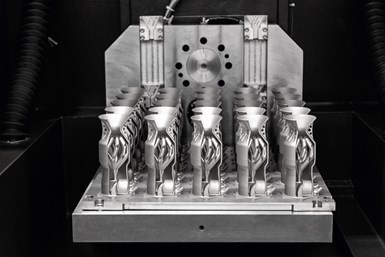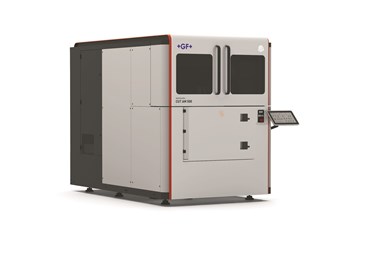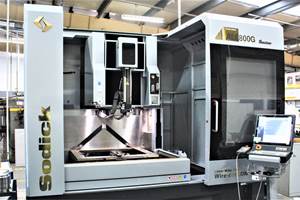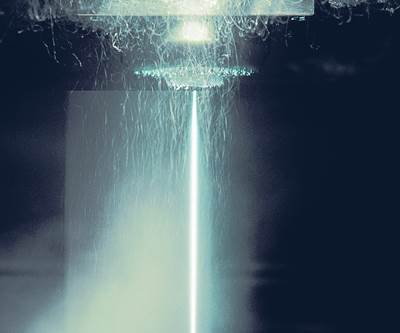Cutting AM Parts from Build Plate Turns Wire EDM Upside Down
GF Machining Solutions found it had to modify nearly every aspect of a wire EDM machine to efficiently handle the challenges of removing 3D printed parts from build plates. Here is a look at a machine tool developed entirely for the needs of metal additive manufacturing.
Share








Autodesk, Inc.
Featured Content
View More
Hwacheon Machinery America, Inc.
Featured Content
View More

Wire EDM machines are a common choice for removing additively manufactured parts from build plates, but traditional wire EDM machines pose a number of challenges. GF Machining Solutions developed the CUT AM 500, a wire EDM machine that is specifically designed for this task.
Metal additive manufacturing (AM) users have two main options when it comes to removing their parts from the build plates onto which the parts were printed: sawing using a band saw and electrical discharge machining (EDM). Because neither of these machines was specifically developed for the purpose of removing parts from build plates, each has its own set of pros and cons.
As a supplier of EDM equipment, GF Machining Solutions wanted to know more about how manufacturers were using wire EDM to cut metal AM parts from build plates, so it began reaching out to those who were using the company’s EDM machines for this application. “We did a survey of those customers, asking them what their main issues were using EDM. And we collected quite a bit of data from that,” says Eric Ostini, head of business development at GF Machining Solutions.
Using the results from this survey, the company developed an EDM machine that is specifically designed for build plate removal. The CUT AM 500, which was released in late 2019, can handle parts made via any powder bed fusion process, as long as the material is electrically conductive. In developing the machine, GF Machining Solutions found it had to modify nearly every aspect of the traditional wire EDM machine in order to handle the challenges of this single application.
Survey Says…
The survey results highlighted a number of issues with using traditional vertical wire EDM machines for removing parts from build plates. According to Ostini, one of the major problems customers brought to the company’s attention was the difficulty of mounting build plates in a vertical wire EDM machine. Because of the orientation of these machines, the build plates have to be loaded into the machine and held essentially on-end relative to the way they’re held in the additive manufacturing machine. These build plates are typically 10-inch by 10-inch steel plates that are between an inch and an inch-and-a-half thick, so they’re heavy on their own. “Right away, just the build plate alone is awkward to hold sideways, and it’s awkward to clamp it to the table,” he says. “Let alone, you have something attached to the build plate, something you’ve grown, so that throws off the center of gravity of the part and makes it even tougher to put it into the machine vertically instead of horizontally.” Customers reported using overhead cranes to load the machines, and a number of methods, including C-clamps, to hold the build plates in position. Not only is this time-consuming, but it also posed safety problems. And these problems are only expected to increase as build plates get larger and heavier.
Another major issue pertained to how parts detached from the build plate in a vertical wire EDM. As the wire cuts, the flushing of the dielectric fluid can cause parts to wiggle and touch the wire, or start bouncing off it. If the part bounces on the wire, the machine goes into a protection strategy that slows the cut. And if the part comes into contact with the wire, the machine eventually short circuits. Users would slow cutting speeds in order to prevent these issues.
The orientation of the build plate in a vertical wire EDM machine also means that parts with delicate features, such as thin walls, are prone to damage as they detach. Parts would fall on top of one another, or hit the bottom of the machine’s tank. “Users would put a lot of thought into how to stagger the parts on the build plate so that when they dropped, they’d drop in between parts instead of dropping on top of each other,” Ostini says. Some users also reported fixturing delicate parts with magnets, or gluing rubber bands to parts so when they fell away from the build plate, they wouldn’t hit the lower arm of the machine.

Users can mount a build plate right-side up into the CUT AM 500, and the machine flips the plate upside down to remove the parts with a horizontal wire. This helps protect the users, the machine and the parts.
Turning Wire EDM On Its Head
Looking at the issues users reported in the survey, it seemed to GF Machining Solutions that a horizontal wire EDM machine would be a natural fit for cutting parts from build plates. “As you cut with a horizontal wire, the parts fall away from the wire,” Ostini explains. “They don’t short circuit, you don’t have to have those protection strategies kicking in, and therefore you can cut much quicker.” However, this would require the build plate to be mounted in the machine upside down. According to Ostini, this proved to be the biggest challenge in developing the CUT AM 500.
The company eventually developed a system for the mounting. Users place the plate on the machine’s table right-side up, and clamp down using the same screws that hold the plate in place on the additive machine, or toe clamps, a chuck or another clamping system. Once the plate is clamped to the table, the machine rotates the table to flip it upside down. “As far as health and safety, it’s very simple,” Ostini says.
With the table upside down, the wire moves into position and cuts across the build plate horizontally, from front to back. The parts are sliced from the build plate and gravity pulls them down, away from the wire. Ostini says most customers don’t require parts to be supported as they’re separated from the build plate, so it’s more common for users to allow parts to just fall into the bottom of the tank. For catching fragile parts, the company developed a basket that can be customized to the application. Users can use set screws to clamp parts to the basket, preventing them from falling entirely. The basket can also be configured with channels to separate parts. The basket then functions like a wine crate, with slats protecting parts from touching.
Need for Speed
The layout isn’t the only feature that distinguishes the machine from traditional wire EDM. It’s also faster, for various reasons. Having the parts fall away from the wire without bouncing or making contact means that users no longer have to slow cutting speeds to prevent these issues. And because the machine doesn’t encounter these issues, it doesn’t automatically go into protection mode.

The CUT AM 500 uses a 0.008-inch diameter molybdenum wire. It’s thinner than traditional EDM wire, allowing a smaller “sacrificial area” for the AM parts, and the wire is stronger, enabling faster cutting speeds.
The choice of wire also helps increase cutting speeds. The machine uses a 0.008-inch diameter molybdenum wire, which is stronger than traditional EDM wires. According to Ostini, it’s less prone to breaking and users can put more power into it, increasing cutting speeds.
The dielectric is also specially formulated for speed. Instead of using distilled water, a common dielectric in traditional EDM machines, the CUT AM 500 uses distilled water with additives to increase conductivity. Ostini says that while the conductivity of dielectric for a standard wire EDM application is typically between 20 and 5 microsiemens per centimeter, the conductivity of the CUT AM 500’s dielectric is almost 2,000 microsiemens per centimeter. “We are thousands of times higher than what a standard wire EDM machine is,” he says. “That adds to the ability to cut fast in the machine.” This enables the machine to use wire speeds of 20 meters per second, siginificantly faster than the wire speed of a traditional wire EDM, which moves at about 13 meters per minute. This speed is essential to the cut. “We don’t use any flushing like standard wire EDM machines use in their machines,” Ostini explains. This is because it’s difficult to flush dielectric into the cut when removing parts from a build plate. There are multiple cuts occurring at the same time, and the parts can block the nozzles from flushing dielectric towards some of the cuts. Ineffective flushing can slow the EDM process and make it more prone to wire breakage. However, GF Machining Solutions determined that by drastically increasing the wire speed, the wire drags fresh dielectric into the cut, creating a flushing action. As a result of avoiding that slowing, “what we’re seeing is not just a little bit faster, but we’re looking at almost 300% faster [cutting] than a lot of the other wire EDM machines,” he says. “A part that would take 8 hours in a standard wire EDM machine to slice off the build plate, we’re doing it in 1 hour and 20 minutes.”
“What we’re seeing is not just a little bit faster, but we’re looking at almost 300% faster than a lot of the other wire EDM machines.”
Battling the Band Saw
When developing this machine for AM, GF Machining Solutions knew it wasn’t just competing with vertical wire EDM machines. The machine also had to be able to compete with band saws, which are another common option for removing parts from build plates.
The advantage of EDM generally over band saws for removing parts from build plates is that EDM requires a smaller “sacrificial area.” When a metal AM part is grown on a build plate, the very bottom of the part that’s attached to the build plate is considered sacrificial because it’s cut away when the part is removed from the plate. The size of this sacrificial area depends on the method of removing the part. Traditional wire EDM uses wires from 0.010 to 0.012 inches in diameter, so the sacrificial area needs to be slightly larger than that, in the 0.014-inch range, Ostini says.
Although band saws can cut faster than EDM machines, they’re less precise. The blades dull as they cut, and they don’t always cut in a straight line. This means that parts removed from the build plate with a band saw require a larger sacrificial area, typically between 0.030 and 0.060 inches, according to Ostini. This larger sacrificial area could add significant cycle time in the AM machine. “You’re adding hours to the build time in order to cut faster with a band saw,” he says. “That doesn’t make sense.”
Because the CUT AM 500 uses a 0.008-inch diameter wire that’s thinner than traditional wire EDM machines, it requires a smaller sacrificial area, typically 0.010 or 0.012 inches. “You’re reducing the time it takes to make the part in the additive machine, and yes, it is not as fast as a band saw machine,” Ostini explains, “but because of the extra growth you need to do for the sacrificial area of the build, it outweighs it.”
The accuracy benefits over band saws will increase as build plates get larger, Ostini notes. “You’re only able to put so much tension onto the band before it will start to bow more in the center. That means your sacrificial build area has to be even bigger in order to keep the blade of the band saw from digging into your part as it’s cutting through,” he explains. “Whereas with a wire EDM machine, the wire is very light, and only needs a little bit of tension to keep it nice and straight in the cut.”
The company also developed the machine to be closer to a band saw in terms of costs. The CUT AM 500 only has two axes (a y-axis, so it can go front to back, and a z-axis to go up and down) compared to the four axes on a traditional wire EDM. Consumable costs are also low because the machine re-uses the wire. As the wire cuts through the part, it goes from one spool to another, where it’s reversed and cuts through the part again. “Instead of a typical EDM machine, where you use the wire once and it gets thrown into a basket for recycling, we are actually re-using the wire back and forth, kind of like a knife cutting through bread,” Ostini says. The increased cutting speeds also reduce the amount of wire used, further reducing costs.
Designing a Machine for the Future
Additive manufacturing technology is rapidly advancing, so the company developed the machine to work with the next generation of equipment. For example, although most additive machines use 10×10-inch build plates, the CUT AM 500 can handle plates as large as 20×20 inches (specifically, 500×500 mm). “We already know the next size up of build plates are going to be somewhere in the 18- to 20-inch size, so we built the machine for the near future of what we saw from additive during that survey,” Ostini says. “And of course, we have the ability to make it bigger as the industry makes bigger machines.”
The machine is also ready for full automation, even though powder bed AM isn’t there yet. According to Ostini, robots don’t yet have the ability to reach into the AM machine and grab the build plate through all of the loose powder. In the meantime, the CUT AM 500 can be incorporated into what Ostini calls a “semi-automatic process.” This process uses tooling from System 3R (part of GF Machining Solutions). The tooling system consists of smaller squares that sit on top of a build plate and act as mini build plates onto which the parts are grown. When the parts on these “mini build plates” come back from heat treat, they can be attached to a pallet, making them easy to load for secondary operations, including EDM. “As additive grows and we figure out a way to use a robotic system to remove the build plates from the additive machine and bring them to the secondary operations, we’re ready for it,” he says.
Related Content
Wall Colmonoy Acquires New Wire EDM From Sodick
The company will use the new wire EDM machine to increase capacity, improve cycle times, achieve tighter tolerances and improve surface finishes.
Read MoreElectrical Discharge Machining in Ten Articles
This roundup of the top ten Electrical Discharge Machining articles on Modern Machine Shop covers the wide range of EDM topics.
Read MoreBelmont Small-Hole EDM Features Multitasking Capabilities
The SY-4060 provides automatic depth control, three-step control of EDM parameters and conversational G- and M-code programming.
Read MoreMC Machinery Displays EDM, Precision Milling, 3D Printing
IMTS 2024: MC Machinery Systems showcases an array of EDM and precision milling tools, as well as a wire laser metal 3D printer.
Read MoreRead Next
CNC Machining as a Business Strategy for 3D Printing
As the additive manufacturing company 3rd Dimension Industrial 3D Printing prepares for production, it has one critical advantage over the competition: a standalone CNC machine shop.
Read MoreOnline Store for EDM Wire Gives Small Shops A Boost
Online ordering of a small number of EDM wire in spools encourages small shops to use premium wire types for faster cuts, better results and overall lower cost.
Read MoreBuying a Wire EDM, Part 1: How It Works
Wire EDMs can cut parts that require a level of accuracy, intricacy and fine surface finish that traditional machining methods cannot achieve. Here’s how it works.
Read More


















.png;maxWidth=150)























